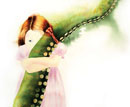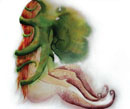For a better understanding of Alejandra Alarcon’s work, the 34-year-old talented artist, it must be said that she was born in Cochabamba, a city of Bolivia where family is a strong and highly-valued institution. Life there is peaceful and many traditions have lived out, traditions the artist either accepts or rips apart. Alejandra went to college and graduated with a degree in Sociology. Later on she traveled to Mexico and got a degree in Plastic Arts at the National Institute of Fine Arts (INBA). She currently works at a white-heat pace between Mexico and Bolivia, showcasing her artworks as well in Italy, China, the U.S., Spain, Brazil, Belgium, Chile, Canada, Argentina and Peru.
All along this path, she found the catalyst that complements her interest in doing a self-referential work: the book entitled Jocasta’s Children by Cristiane Olivier, a volume that blasts psychoanalysis by raking the role played by Oedipus’ mother in the tragedy. The author explains that Jocasta is partly to blame for the drama Oedipus goes through. The book spells out the myth from Jocasta’s standpoint and unravels the dominating darkness that devours the motherly role. Based on this episode, Alejandra Alarcon develops a thriving piece that pans out to be the backbone of her creation, a creation that embraces drawings, watercolors, videos, installations and objects.
In this stage of her creation, she had to do with the imaging of children’s tales, specifically White Snow and Little Red Riding Hood. In White Snow, she is drawn to the main character’s ties with her stepmother –she’s indeed her mother– which is a relationship of rivalry and competition from both sides. As to Little Red Riding Hood, Alejandra comments: “I reached a borderline where identity is constantly being bargained with the other, in which “being” is not something taken for granted or unmovable, but rather something that’s ever-changing. Little Red Riding Hood is the wolf and vice versa”.
In Little Red Riding Hood there’s a pervert game: the image of the innocent girl stacked up against the one of a woman who knows and masters seduction. The perversity of the “innocent girl” prevails. Men feel strong in the face of this image of vulnerability: she “plays” to get caught when indeed she’s in full control. The power of a woman hinges on her apparently weakness.
At an artistic level, there’s also a pervert relationship between the first appearance and their content, a bond she makes stronger through the watercolor technique. The first impression when anyone takes a look at her works is pure attraction. They feel good for their transparency, neatness and colorfulness; they seem naïve, open-minded and harmless. In a second look, though, the true intention surfaces and the image packs a different wallop. The neatness, the transparency are just forms since the content is sometimes gross and grotesque. That’s exactly what happens in Little Red Riding Hood, an apparently candid, childish and unprotected little girl who’s indeed aggressive, instinctive, animal and dangerous.
When debunking the myth of children’s tales, certain individual and collective images that perpetuate a civilizing morality, Alejandra lays bare the unconscious contents of the petit and big-ticket existential dramas contained in those stories. She builds a new iconography by means of her deconstruction.
Among the functions art might have, redemption could be a key element in Alejandra Alarcon’s work, and she gets there through the comprehension of reality, of the complex personal relationships and the behaviors that are generally analyzed or understood in the fields of psychology and sociology. And she splays all this much in her works with irony and humor just to deny the weak genre’s victim stance, just to put a new spin on children’s tales and put them in a new place. The game among innocence, seduction and power is the axis her work revolves around.
She finds resources so uncommon in the 21st-century contemporary art –the use of watercolors– as working through the contents and esthetics seen in children’s tales by giving them a new dimension. The end result is a proposal so serious that it touches the deepest fabrics of our psyche, that mind order likened to the functioning of intellect, emotions and willingness.
My work spins around a preoccupation on female identity, the passage through a borderline in where identity is constantly being bargained with the other, in which “being” is not something taken for granted or unmovable, but rather something that’s ever-changing.
It’s in my best interest to dismantle the images that support the West culture, like children’s mythology (fairytales), the underpinnings of the images created around the family as the legitimizing institution within society. Delve into the post-feminism on which I build a new feminine image powered up by seduction, but equally dangerous in its neutering nature.*
The series entitled The Smell of the Clan is by far one of the finest works Alejandra Alarcon has embarked on up to now. Strong, uneasy, mysterious, teeming with an extraordinary expressive ability marked by a come of age in transmitting the relationships of the family clan. The octopus is the poetic image that takes us into this fascinating world of archetypical relations:
I’m lured to the octopus for its features, its soft and wet texture. The octopus’s physiognomy alludes to the both the woman’s sexual organs (toothless mouth) and the man’s (the tentacles). Characters are related among themselves by real or symbolic kinship within a clan.
The abovementioned clan refers to family as a group in its biological and social aspect, with genuine feelings of affection, high level of cooperation, similar behavioral patterns, shared rituals, common values in which a nearly inevitable centripetal force comes along, perhaps out of tradition or maybe because it perceives the unconditional protection of the household in which the strong bonds of consanguinity determine the behavioral patterns recognized by the group and provides the necessary emotional stability to break free from the household in certain aspects. Relationships that sail between recognition and denial, between dependence and liberation, between the need to build an identity of your own and the desire of belongingness to the group, the need for lineage.
In a clan, relationships among members can go beyond the blood or real ties, and also become symbolic or mythical, let alone have a matriarchal layout. I’m interested in relationships among characters and the tragic passages they go through based on the recreation of relationships within the family…
I’m drawn to them with a stigma of belongingness that surpasses the idea of being part of a much bigger thing that induces them to accept their fate, a tragic date in which relationships, love affairs, hatred are all taken for granted, yet they can be so strong that they could bind together some human beings, to make them talk about what they don’t see.
Belonging to a family compels us to carry stigmas that determine certain behaviors and, at the same time, our destinies. The closer they are bound to it, the more it determines the individual identity: “What if you don’t have them? It’s like branded belongingness that goes us one better.”
Her audiovisual creation is no doubt just another field of success for Alejandra Alarcon. She comes up with a previous script and computerized animations she scours the aspects of human behavior with and in which acid humor plays a key role. By using a video camera that lets her take a new dynamics, she builds on discourses with esthetics of her own. One of the outstanding artworks is Sewed Dress, a brief animation in which a piece of meat chases a dress around, jumps into it and winds up cooked. Alejandra is clearly pointing to the victim-victimizer relationship and the female-male linkage in which the woman in her man-eating role is not indeed a man-eater, but a being in control that holds both power and pleasure.



Related Publications

How Harumi Yamaguchi invented the modern woman in Japan
March 16, 2022












